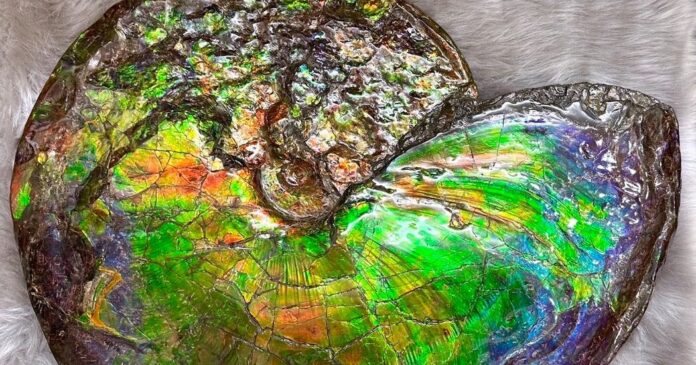Millions of years ago, ammonites – squid-like creatures – ruled ancient oceans. Though these fascinating animals are now extinct, their beautifully preserved shells have become a source of both scientific inquiry and breathtaking beauty: the vibrant gemstone known as ammolite. This shimmering gem, often found in fossilized ammonite remains from the Bearpaw Formation in Alberta, Canada, boasts a captivating array of iridescent colors. But what gives ammolite its unique glow?
Recent research published in Scientific Reports by Hiroaki Imai and his team at Keio University in Japan offers compelling answers. The study reveals that ammolite’s mesmerizing hues are a result of incredibly intricate structures formed within the shell, showcasing a fascinating interplay between biological and geological processes.
At the heart of this phenomenon lies nacre, also known as mother-of-pearl – the iridescent layer found inside many mollusk shells, both living and fossilized. Ammonites’ nacre is composed of meticulously layered plates of aragonite (a type of calcium carbonate mineral) interspersed with minute gaps filled with air. The precise thickness of these aragonite plates and the consistently sized air pockets between them are crucial to ammolite’s vibrant coloration.
These tiny structures act as microscopic prisms, reflecting specific wavelengths of light depending on their size and spacing. When white light strikes this intricate arrangement, it gets diffracted – separated into its constituent colors – creating the dazzling play of iridescent shades that characterize ammolite.
“We were thrilled to discover that such an exquisite structure is created through the collaboration of biological and geological processes,” Dr. Imai noted.
The team compared nacre from ammonite fossils found in Canada and Madagascar, along with similar layers from abalone and nautilus shells. While all specimens displayed stacked aragonite plates, the variations in their thickness and air gap sizes were key to understanding ammolite’s unique brilliance. Notably, even when organic material present within modern shells like abalone was removed, these shells couldn’t replicate the intensity of color seen in ammonites from the Bearpaw Formation.
This suggests that a specific combination of factors – the uniform layering structure and the precisely sized air gaps present only in certain ammonite fossils – are responsible for the exceptional iridescence observed in ammolite.
“That was a very valuable contribution of this paper,” commented geologist Paul Johnston from Mount Royal University, who wasn’t involved in the study. He likens the arrangement within these shells to tiny bricks with consistent spacing, formed through fossilization processes unique to those particular ammonites found in Alberta.
While ammolite is known to originate from various ammonite species found along the Bearpaw Formation, not all produce this vibrant gemstone. Some remain white or creamy in color, prompting further questions for researchers.
“There’s some kind of geological difference that we haven’t figured out yet,” Dr. Johnston observed.
This discovery opens exciting avenues for future research into the precise geological conditions that fostered these remarkable iridescent fossils within the Bearpaw Formation.
Neil Landman, curator emeritus of fossil invertebrates at the American Museum of Natural History (not involved in the study), echoed this sentiment: “This, for me, is like the crossover between science and art.”
He considers the research a springboard for investigations into the unique geological factors influencing iridescence in these ancient fossils. The interplay of life and geology that created ammolite serves as a stunning testament to the intricate beauty hidden within our planet’s history.


































